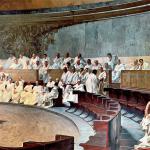
We’ve been posting about the “dechurching” phenomenon in America, the dramatic drop-off in church attendance and affiliation. The definitive book on the subject is
Two of the authors, Jim Davis and Michael Graham, have written a useful piece for the Gospel Coalition entitled 5 Misconceptions about Dechurching in America. It distills some counter-intuitive information that Christians who would like to reverse these trends need to be aware of.
I’ll just list the misconceptions, with just a few words of explanation. Read the article for a full treatment of each point.
Misconception #1: People leave primarily because of negative experiences with the church.
It isn’t Trump, clergy scandals, mistreatment of women, wokeness or anti-wokeness that is driving most people away, though such things are a factor for a few. The biggest reason for no longer going to church: Moving.
Other things–such as kids’ sports on Sundays, family changes, inconvenience, and the like–have gotten them out of the habit of church-going.
Misconception #2: Young people are leaving the church after attending secular universities.
On the contrary, greater education means more church attendance. The vast majority of those who are dropping out are the less-educated.
Misconception #3: People leave the church because they’ve left the faith.
Some, but a large number of people who leave the church still believe in the tenets of orthodox Christianity.
Misconception #4: The people leaving are primarily on the secular left.
Conservatives are leaving at twice the rate as liberals.
Misconception #5: They aren’t willing to come back.
More than half of those who have left evangelical or conservative churches are willing to come back.
So how can congregations get people who have moved, who are less-educated, and who are conservatives back to church, which they are quite willing to do?
Discuss.














